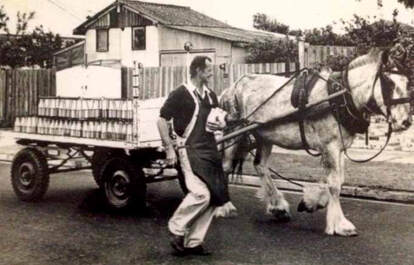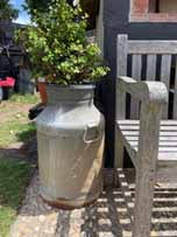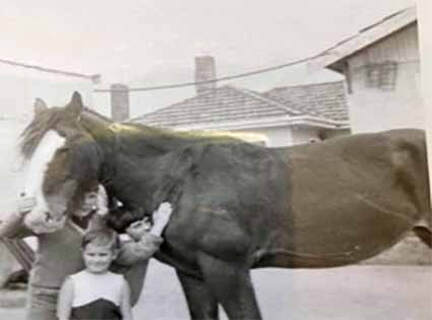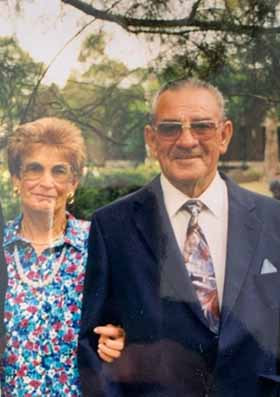 Photo courtesy of Altona Historical Society
Photo courtesy of Altona Historical Society LAST summer the Wonthaggi Historical Society held a series of “15-Minute Talks,” which usually lasted for half an hour and only ended when the mine whistle blew everyone out of their seats and rendered the speaker silent. The talks were well attended and always interesting.
One of the most thorough and meticulously prepared talks, that could have kept the audience spell-bound for another hour were it not for the mine whistle, was given by Peter Hanley. It was based on the recollections Peter (the second born of seven children) and his mother had of Hanley’s Dairy, which operated on McKenzie Street from 1960 until 1983 and was owned and managed by Peter’s parents, Chick and Sadie Hanley. (While Peter and his mother were comparing memories of the family business and the people they worked with, they sometimes had to correct one another and had to admit that others might have different recollections. Nevertheless, the detail is wonderful.)
Daily routine
Running a business such as Hanley’s Dairy in the `60s and `70s, before the horse-and-cart days were overtaken by motorised milk trucks, was complex and relied on honest workers dedicated to the smooth running of a stressful daily routine that could easily come undone. It required workers willing to rise at 4am and set to work without delay loading carts from the cool room with milk (bottled or bulk) and cream (bottled), harnessing horses in their stables, leading them to their milk carts and hitching them up; then commencing home deliveries in the pre-dawn to be completed by 8am, when they would return to the dairy and unload and clean the milk carts, all before washing and cleaning and releasing the horses into their turn-out paddocks.
Various other tasks also had to be completed (some of which were the responsibility of the Hanley children before and after school). These included bringing coal from the backyard coal stack to the kitchen; cleaning the stables, the washroom, and milk carts and trucks; sweeping the landing and loading bay; stabling horses in the late afternoon; delivering late orders; and myriad household jobs. Most importantly, they had to make sure the cool room was ready later in the day for Arthur’s Dairy milk truck from Frankston to deliver the next day’s supply of milk and take away the rinsed and stacked crates of empty bottles, which would be sterilised and re-filled at Arthur’s.
“You can whip our cream, but you can’t beat our milk.” |
On top of all this, each milkman had to “book in”, which was a complex system of keeping track of who gets what each morning at each house all along the milkman’s route. This entailed the milkman completing an A3 size ledger with the customers’ names, the number of bottles or pints of milk and/or cream delivered, as well as indicating if the milk had been paid for if a cash customer (or not and then they would be invoiced). If they were account customers, the milkman had to keep track on the ledger of how many bottles of milk or cream were delivered over a two-week period. Not so easy to keep the tally straight on the page in the dark as you are running from cart to house and back to cart again.
The milkEvery day for twenty-three years Arthur’s Dairy delivered a truckload of pasteurised milk and cream to Hanley’s Dairy. Upwards of 100 crates per day of bottled milk and about five crates of cream, mostly on Fridays and Saturdays, came from Arthurs’ Dairy, which was one of three certified retail suppliers to the South Gippsland Milk District. Hanley’s Dairy was the certified wholesale and retail supplier to the ‘Municipal District – Wonthaggi’ as was stipulated by the Victorian Milk Board Act 1958 Victoria.

The milkmen
Donald Batten, Bob Main, Graeme Buck, Geoff Hoghton and sons – Geoff, Alan and Greg – at various times, Col Davidson, Gilly Dunstan, Kevin Cooper, Barry Dunstan, Alan Ennoss, Frank (Titch) Loughran, Stan Whitford (jnr), Peter Hill, John Poole, Rob Batten, Lawrence Fox, and Clive Dobson, were among the workers who stayed with Hanley’s the longest.
Chick was a bloke’s bloke, who guaranteed his men work, provided they could cope with the rigours of a typical day. His men were very adaptable considering all they had to do. The first thing Chick did when he hired a man was to explain what was needed and then he would allow them to learn, make mistakes and try again. The strength of his workforce, Peter reckons, was his expectation that once learnt, always remembered. New milkmen were taught skills, not by Chick but by the ‘old-hands.’ It was terrific to watch them understand. Chick placed great emphasis on ‘getting on with it’. Oh, it helped if you could play footy too. But that’s another topic.
The first man on the list of milkmen in Peter’s memory was Donald (Don/Duck) Batten, who worked for Chick for eleven years, starting as a 14-year-old in 1960. As Don told the story, he reckoned he was maybe thirteen-and-a-half when he saw a horse partially harnessed, bolting along Hagelthorn Street being chased by ‘some bloke’. “Well,” Peter remembers, “in Don’s version of the story, he catches the horse, backs it into the shafts, re-attaching the harness, girth strap, shaft chains and reins. Chick is mightily impressed and so begins an eleven-year job, which developed along the way into a very strong family friendship.”
It was Don who stayed on when the great credit squeeze in 1966 created financial hardship for the dairy. He chose to stay on without pay until the squeeze was released. ‘I’ve got nothing else to do.’ he said. He and Chick worked unpaid for a couple months and ‘saw it out’. Don also remembers, after being informed by a concerned neighbour, seeing Terry, Peter’s younger brother who must have been about four years old, leading a horse along the McKenzie St/Strickland St back lane in the early morning. Terry can’t remember this; perhaps he was sleep-walking. Nevertheless, Don saved the little fellow and the horse.
The horses
The horses all had names: Lofty and Dolly (Titch Loughran told Peter they were named after Lofty and Dolly Hill), Nelly, Pandy’s Demon, Dandy, Blacky, Ginger and King.
 Terry, Patricia and Marita with Dolly, a big and gentle Clydesdale – circa 1968.
Terry, Patricia and Marita with Dolly, a big and gentle Clydesdale – circa 1968. Vic Benetti was the farrier. The forge, fuelled by coal of course, blowing the bellows enhanced by a Chick-adapted oxygen cylinder, boggled the senses of onlookers as the glow of horseshoes reached very high temperatures. The clang of hammer on anvil rang as Vic found the desired shape. The smell was awful, when, to get a proper fit, the farrier placed the almost red-hot shoe on the horse’s hoof wall, searing it. The forge, I think, came from the State-Coal Mine’s stables, was installed, and made workable by Chick. Clever man, Chick.
Accounts day
It wasn’t all men who ran the show at Hanley’s Dairy. It was the women who kept the accounts. Maureen Macdermid and Margaret Ennoss were employed at different times during the 23 years to do the accounts. Accounts day was each alternate Thursday and involved using the daily book-in ledgers to complete each customer’s fortnightly invoice.
 Sadie and Chick Hanley, 1980s
Sadie and Chick Hanley, 1980s Starting mid-morning, after the day’s entries in the book-in ledgers were made, Maureen or Margaret sat around the dining-room table, usually with Chick doing the same and Sadie keeping everyone well fed, each working with their allocated customer group. They would tally the fortnight’s deliveries, calculate the associated cost sometimes using an electronic adding machine, enter the customer’s name, data and amount owing onto a blank Hanley’s Dairy invoice docket (approx. 4” X 6”), stamp the date with a self-inking device then finishing the account, writing their signature in a designated area on the docket. Chick always did the retail customers himself. He would then countersign every invoice with his flourished signature. He always took great pride in his neat handwriting. By mid-afternoon, after lunch on-the-go, with invoices completed and blank spare invoices, pens, adding machines, cups of tea partially empty, empty sandwich plates, now covering the table, you’d think it was done.
Not quite.
The next and last stage was to arrange the invoices into stacks according to rounds and order of delivery. So, for example Donald Batten’s household customers’ invoices would be arranged with the last customer’s invoice on the bottom of the stack and his first customer on top. This made Don’s work easy for him to take his next customer’s invoice in his stack and place it next to their milk/cream bottles/billy and so on. The location of deliveries was often convenient for both customer and the milkmen, but not always. Remember, Don’s working in the pre-dawn light, it could be raining with some invoices damp, his horse – Lofty his favourite - might be frisky, the battery on his cart may or may not have enough power to run the lights on his cart. A challenge, of course.
There were other customers that needed invoices besides the households on the north and south sides of the railway line. These were retail customers: the hotels, milk bars, cafes, the Cape Kiosk, Sandy Point, South Dudley stores, and the Stortis at the Hunter Street Dairy to name a few. There was no invoice for school milk that was delivered early in the morning and sat in the sun until it was nice and warm. Every kid had to drink it since it was provided by the government for free in small 1/3-pint bottles that left milk moustaches every day on every kid.
Maureen recalls Chick having a special thing for people who owed money but were doing it tough. He’d say, “forget that one” for a family whose account was about $10. ‘Forget that one’ was a two-fold instruction: wipe the debt; and don’t send the invoice.
Honesty prevails. A debt of $25 was paid by the widow of a hard- working miner years after Hanley’s Dairy had finished trading, a small but significant example of the goodness and loyalty of a hard-working mining family.
This essay was first published in The Plod, the newsletter of the Wonthaggi & District Historical Society.